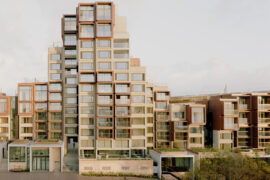Distance is no barrier to global impact for New Zealand-based studio Formway Design. An international perspective and the creativity fostered by a remote location bring a unique point of view on workplace furniture to the world.
Kent Parker and Paul Wilkinson, the Joint General Managers and Lead Designer and Engineer (respectively) at Formway Design, have no qualms about the word ‘antipodean’. They are based on New Zealand’s north island in the city of Lower Hutt, nestled between a mountain range and the sea.
“Yes, we are way down there!” jokes Parker as we chat in Zenith’s Singapore showroom. There are 45 hours of travel time between them and the headquarters of European brands. He adds, “It makes us hungry to know what’s going on everywhere else and it makes us naturally resourceful. New Zealand is full of creative businesses that have been established out of need. But there’s also an advantage in the fact that we can stay away when we need to, and just focus on what we do.”
And what they do could be summarised as such: creating products that will really help people in their lives. Formway Design focuses on intuitive performance seating. “That’s where we want to push the boundaries,” says Parker. “It’s always been part of our culture to figure out how people can work better, and how we can affect that,” he adds.
The Life chair, designed in 2002, is a great example of a winning solution. It’s Knoll’s highest-selling task chair. The Be task chair (known as the Generation chair in the US) is selling around 160,000 units per year, notes Parker. He also cites Formway’s first showing at NeoCon in 1996, when the studio presented the Free desk system – a moveable, flexible plug-and-play design. It won four ‘Best of NeoCon’ gold awards at the fair.
The key to Formway’s impact is perhaps the rigour with which the team evaluates everything they design. Says Parker, “We don’t just want to create another chair or another table. We want to create solutions to make everyday lives richer. We mark ourselves quite hard; we ask, ‘What’s the real benefit of this product?’”
Research is a huge part of arriving at meaningful solutions, and – though you might expect it to have an impact in this regard – the distance at which Formway Design works is no barrier to investigating working and living trends at a global scale.
Part of the key to Formway’s reach is maintaining a large international network of contacts. With the help of this network, the studio carries out observational work, with cameras set up in workplaces and homes (“People are actually really open,” remarks Wilkinson); undertakes global surveys (the most recent one involving 2,000 respondents from Germany, the UK, China, Japan, Australia and New Zealand); and holds face-to-face discussions with customers about how they work and live. The gathered information is carefully processed and the team seizes on opportunities that emerge through data analysis.
Another big part of delivering on-target solutions is nurturing rich partnerships, say Parker and Wilkinson. “Our partnerships with brands like Zenith are all about delivering value at the design end and partnering with people who believe in what we’re doing and can take that to market,” says Parker. These relationships are also another way for the team to keep on top of trends in different markets.
“The trends we’re seeing in Singapore right now are quite different to what we’re seeing in Australia and the US,” says Parker. “These markets are at different stages of the cycle of how people work.” He adds that they have started seeing some pushback in Australia in terms of activity-based working. “You have to get the balance right,” he says. “Not everything has to be collaborative and not everyone works well in open spaces.”
These days, co-working and the ability to work from home are having an effect on the workplace, suggests Wilkinson, and on the types of products designed by Formway. For example, the Belite chair was introduced as a variation of the more technically advanced Be task chair, offering similar performance but a lower price point.
The need for adaptable products that suit smaller home environments is another trend being addressed by Formway. “But I don’t think the traditional office will disappear,” says Wilkinson. “It’s still the place where everybody gets together.”
What is changing in the office is the growing influence of domesticity. “The warmth and domesticity we provide now for work is very different to what we had ten years ago,” says Parker. “We realise that we need to match the functional performance of our products with the aesthetic side.”
Yet the colour primarily specified for task chairs is still black, shares Wilkinson. “It’s a lot easier to change, for example, a laser-cut wall panel than it is to change the office seating, so other products still tend to provide the accents,” he explains.
Of course, it’s a different story in the residential sphere. We’ll watch with interest to see how Formway’s product offer expands to cater to the ever-changing trends of living and working in New Zealand and around the world. Without question, the stoic underpinning of Formway Design’s methods and philosophy will continue to serve the studio and their customers well.
INDESIGN is on instagram
Follow @indesignlive
A searchable and comprehensive guide for specifying leading products and their suppliers
Keep up to date with the latest and greatest from our industry BFF's!

For Aidan Mawhinney, the secret ingredient to Living Edge’s success “comes down to people, product and place.” As the brand celebrates a significant 25-year milestone, it’s that commitment to authentic, sustainable design – and the people behind it all – that continues to anchor its legacy.
Cieran Murphy has been awarded The Photographer – Commercial at the INDE.Awards 2025. His work on Lune Rosebery captures the immersive design and storytelling of the space, highlighting the interplay of form, material and atmosphere in this contemporary culinary destination.

Central Station by Woods Bagot in collaboration with John McAslan + Partners has been named one of two joint winners of The Building category at the INDE.Awards 2025. Recognised alongside BVN’s Sirius Redevelopment, the project redefines Sydney’s historic transport hub through a transformative design that connects heritage with the demands of a modern, growing city.

BVN’s Sirius Redevelopment has been named one of two joint winners of The Building category at the INDE.Awards 2025. Celebrated alongside Central Station by Woods Bagot and John McAslan + Partners, the project reimagines an iconic Brutalist landmark through a design approach that retains heritage while creating a vibrant, sustainable future for Sydney.
The internet never sleeps! Here's the stuff you might have missed

Armadillo collaborates with Barcelona artist Carla Cascales Alimbau on Gaia, a sculptural rug collection that translates fine art into handwoven form.

Lamitak’s Portfolio 2026/27 Collection made its debut in Bangkok with colour, energy and a crowd that celebrated design in full swing.